Understanding ABA Therapy's Role in Emotional Skills Development
Applied Behavior Analysis (ABA) therapy is a well-established, evidence-based approach designed to enhance a variety of skills in individuals with autism spectrum disorder (ASD), including emotional recognition and expression. This method employs systematic techniques to teach important social, communication, and behavioral skills, tailored to the unique needs of each individual. In this article, we explore how ABA therapy can be leveraged specifically to improve emotional understanding and expression, which are often challenging for children with ASD. We delve into the core principles of ABA, effective teaching strategies, and practical tools such as emotion flashcards that support emotional learning within ABA frameworks.
What is ABA Therapy and Its Role in Autism
What is Applied Behavior Analysis (ABA) therapy and how does it help individuals with autism?
Applied Behavior Analysis (ABA) therapy is a widely recognized, evidence-based approach designed to improve behaviors and skills by systematically analyzing and modifying behavior. For individuals with autism, ABA focuses on increasing positive behaviors like effective communication, social interaction, and daily living skills, while decreasing behaviors that may interfere with learning or social participation.
ABA therapy uses strategies such as positive reinforcement, prompting, and careful observation to encourage desired actions. Techniques include structured methods like Discrete Trial Teaching, where skills are broken down into smaller components and taught step-by-step, and naturalistic approaches like Pivotal Response Treatment, which uses students' interests to motivate learning in everyday situations.
Individualized ABA programs are created by trained professionals, tailoring interventions to meet each person's unique developmental needs. Early and intensive ABA—typically started before age four and conducted extensively each week—has been shown to significantly improve cognitive, communication, and social outcomes.
Overall, ABA serves as a foundational therapy supporting individuals with autism to acquire essential skills that promote independence and meaningful engagement in their communities.
Who Provides ABA Therapy? Professional Qualifications and Training
Who typically provides ABA therapy and what qualifications do they usually have?
ABA therapy is typically delivered by professionals trained in behavioral analysis, including Board Certified Behavior Analysts (BCBAs), Registered Behavior Technicians (RBTs), and other specialists focusing on autism and behavioral interventions.
Common providers of ABA therapy
- Board Certified Behavior Analysts (BCBAs): Lead the assessment, design, and supervision of ABA programs.
- Registered Behavior Technicians (RBTs): Implement ABA techniques directly under BCBA supervision.
- Other specialists: Such as special education teachers and therapists trained in ABA methods.
Required education and certifications
Individuals pursuing ABA therapy careers typically hold at least a bachelor's degree in psychology, education, or related fields. Many advance to a master's degree in applied behavior analysis or similar disciplines.
Becoming a BCBA requires:
- A graduate degree.
- Extensive supervised fieldwork (about 1,500 to 2,000 hours).
- Passing a certification exam administered by the Behavior Analyst Certification Board (BACB).
Training and supervised practical experience
Hands-on experience gained under BCBA supervision is critical. Trainees learn to analyze behavior, apply reinforcement strategies, and tailor interventions for diverse needs including autism spectrum disorder and other developmental challenges.
Ethical standards and ongoing education
Professionals must adhere to strict ethical guidelines to ensure effective and respectful treatment. Continuous education and recertification are mandatory to stay updated with evolving best practices in ABA therapy.
This comprehensive training ensures therapists can effectively improve behaviors, communication, social skills, and learning abilities in classroom and therapeutic settings.
Core ABA Principles and Techniques for Teaching Emotional Skills
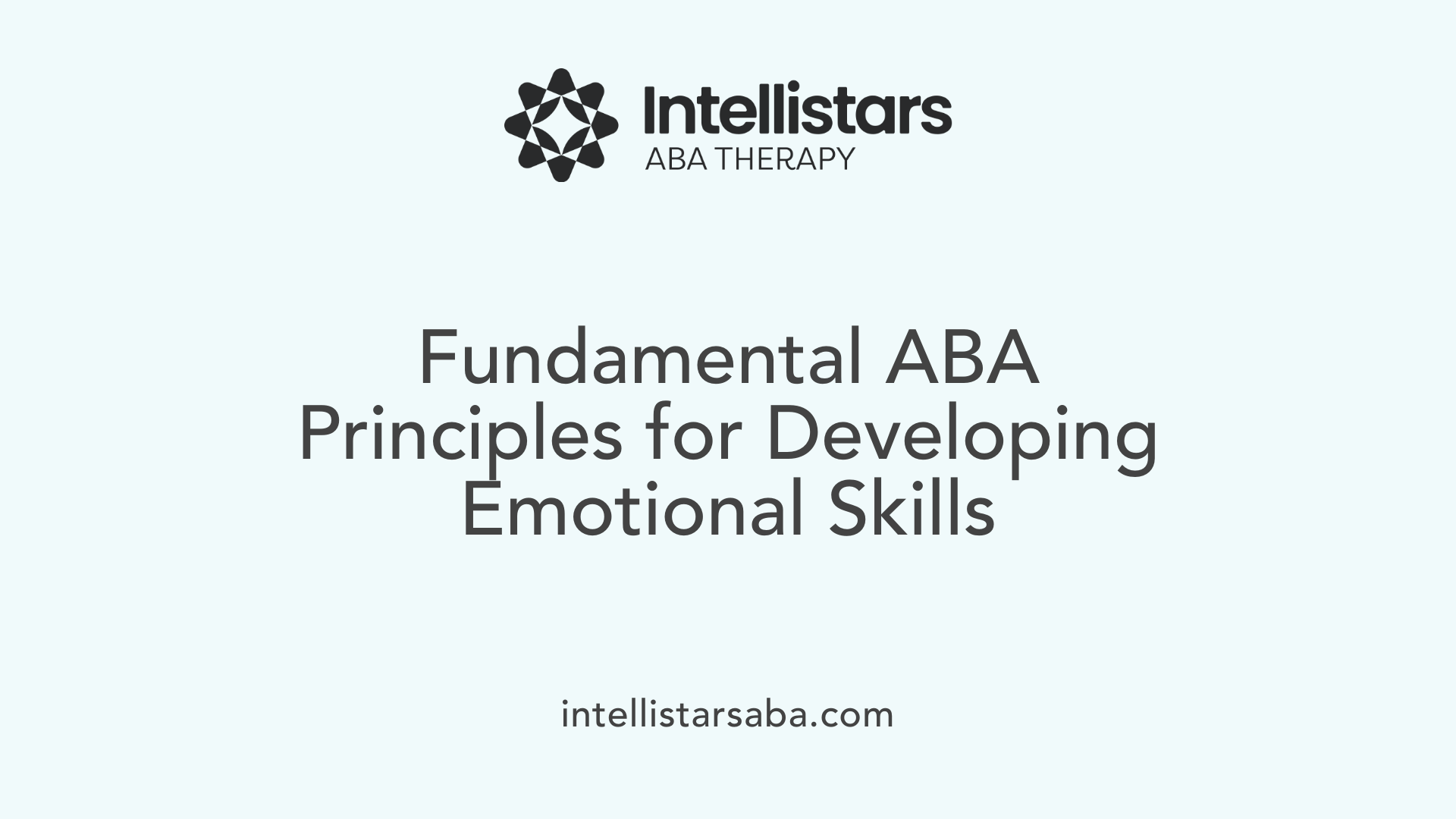
What are the core principles and techniques used in ABA therapy?
Applied Behavior Analysis (ABA) is grounded in understanding how behavior is influenced by the environment. Two fundamental principles are reinforcement — presenting stimuli to increase the likelihood of a behavior — and the ABC model, which examines Antecedent, Behavior, and Consequence to analyze and alter behaviors.
ABA therapy uses several techniques to teach new skills and shape behaviors. These include:
- Prompting: Providing cues or assistance to encourage a desired behavior.
- Fading: Gradually removing prompts to promote independence.
- Modeling: Demonstrating behaviors for learners to imitate.
- Chaining: Breaking complex tasks into smaller steps taught sequentially.
Specific ABA teaching models for emotional skill development
Two notable ABA models applied in classrooms are:
Discrete Trial Teaching (DTT): This method breaks skills into manageable parts, using a cue-and-response format with reinforcement or consequences. It’s effective for teaching social skills and behaviors by offering clear structure and frequent practice.
Naturalistic Teaching: This approach incorporates learning into everyday routines by using students’ natural interests. It involves incidental teaching, encouraging communication and emotional expression within meaningful contexts.
Tailoring interventions and data-driven decisions
ABA interventions are customized to each student’s unique needs, especially for those with autism spectrum disorder or other developmental challenges. Teachers and therapists continuously collect data on behaviors and responses to ensure strategies are effective and adjusted as needed. This data-driven process supports better outcomes in social-emotional skills through ongoing assessment and refinement.
Integrating these principles and techniques into classroom practices creates supportive environments where students can develop essential emotional recognition and communication skills critical for social success.
ABA Teaching Strategies for Enhancing Emotional Recognition
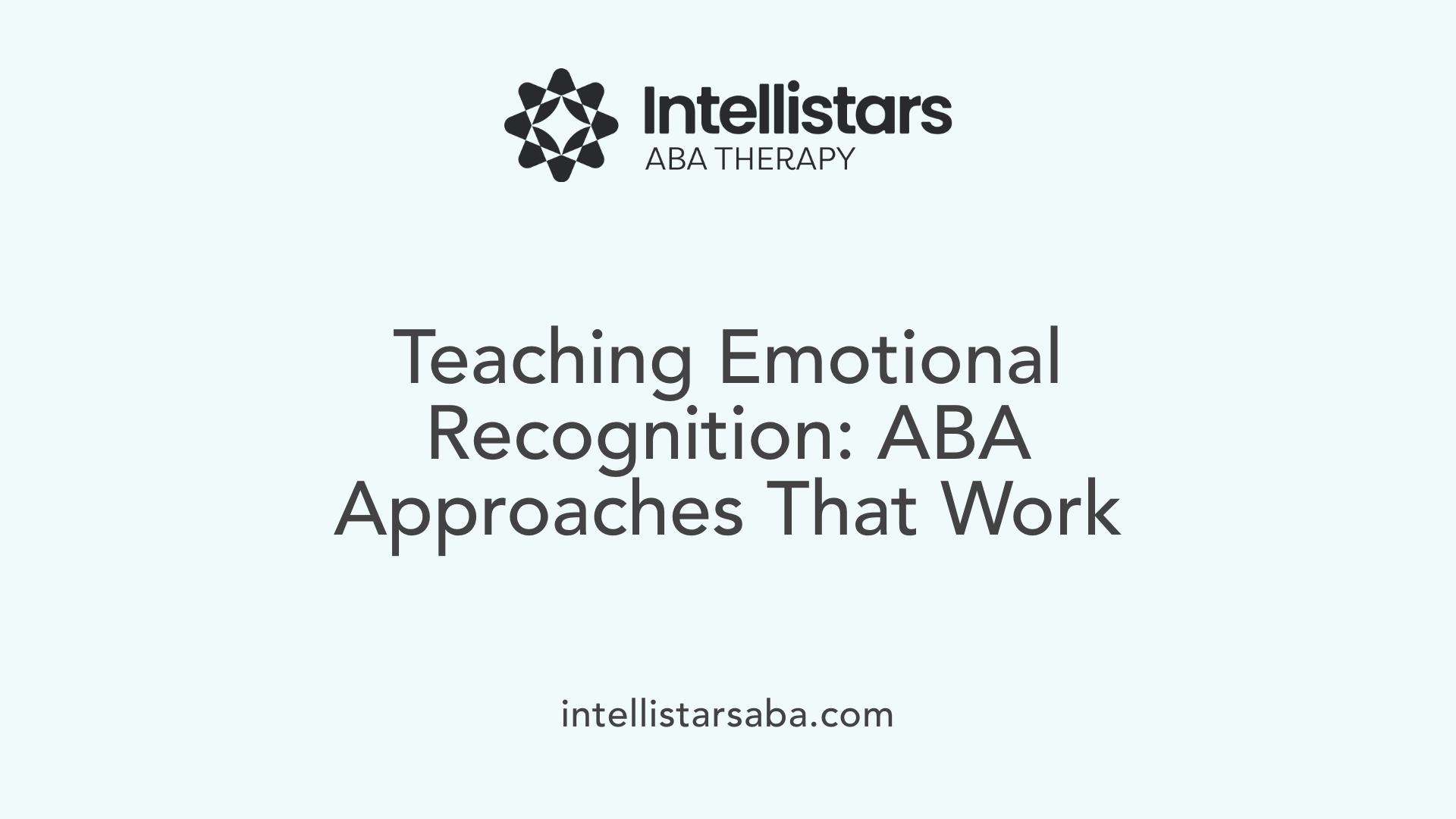
How Does Discrete Trial Teaching Support Social and Emotional Skills?
Discrete trial teaching (DTT) breaks down complex skills into simple, manageable steps using a cue-response format followed by immediate consequences. This targeted approach is particularly helpful for children needing to develop social skills by repeatedly practicing emotional recognition and appropriate reactions. For example, a teacher might use flashcards depicting various facial expressions to prompt the child, rewarding correct identification to reinforce learning.
How Is Naturalistic Teaching Used to Encourage Emotional Understanding?
Naturalistic teaching leverages a child's natural interests and everyday activities to embed learning moments. By incorporating teaching into familiar routines, children with autism can practice emotional recognition in real-life contexts. For instance, during playtime, a teacher may use incidental teaching techniques to highlight emotions expressed by peers or characters in stories, encouraging meaningful communication about feelings.
What Are the Benefits of Pivotal Response Treatment for Motivation and Communication?
Pivotal Response Treatment (PRT) focuses on key developmental areas such as motivation and social initiations. By enhancing these central skills, children experience widespread improvements in communication and emotional behavior. PRT encourages children to actively participate in social exchanges about emotions, making emotional recognition more natural and generalized beyond structured settings.
How Does a Token Economy Reinforce Positive Emotional Behaviors?
Token economy systems motivate students by awarding tokens for positive behaviors, including appropriate emotional responses. These tokens can then be exchanged for preferred reinforcers, which encourages children to practice and maintain emotional recognition and regulation skills consistently. This reinforcement strategy helps create a supportive classroom atmosphere where emotional growth is visibly rewarded.
Why Is Contingent Observation Used to Manage Disruptive Behaviors?
Contingent observation involves temporarily removing disruptive students from group activities to minimize interruptions and model appropriate social behavior. This method allows children to observe peer interactions and the emotional cues that accompany them, which can aid in understanding and adjusting their own emotional responses over time.
| Strategy | Application | Emotional Recognition Benefit |
|---|---|---|
| Discrete Trial Teaching | Structured cue-response learning | Builds foundational recognition of facial expressions |
| Naturalistic Teaching | Learning embedded in routine activities | Promotes understanding emotions in natural contexts |
| Pivotal Response Treatment | Focus on motivation and social initiations | Enhances communication and spontaneous emotional interactions |
| Token Economy | Reinforces positive behaviors with rewards | Encourages consistent demonstration of appropriate emotional conduct |
| Contingent Observation | Manages disruptions by modeling behavior | Facilitates observational learning of emotional and social cues |
Using Emotion Flashcards in ABA to Teach Emotional Recognition
Purpose and design of emotion flashcards
Emotion flashcards are visual tools designed to aid individuals with autism spectrum disorder (ASD) in understanding and expressing emotions. They typically feature clear, exaggerated facial expressions along with contextual cues, and sometimes include scenarios that help clarify the emotions being portrayed.
Benefits for individuals with ASD
Children with ASD often struggle to recognize facial expressions, body language, and vocal tones, making emotional recognition challenging. Emotion flashcards can improve their ability to identify emotions, expand their emotional vocabulary, and enhance social interactions by providing consistent visual references.
Pairing visuals with words and repetition
Effective use involves pairing the images with corresponding emotion words to link visual cues to vocabulary. Repetitive exposure through regular practice helps reinforce these connections, facilitating stronger recognition and recall.
Incorporating interactive games and scenario-based learning
Interactive activities, such as matching facial expressions to emotions or playing games involving emotion cards, engage children actively. Scenario-based learning, where flashcards are used to discuss relatable situations, further deepens understanding by connecting emotions to real-life contexts.
Selecting age-appropriate, durable, and customizable cards
Choosing flashcards that are visually clear and suitable for the child’s developmental level is crucial. Durability ensures they withstand frequent use, and customizable options allow tailoring the content to meet individual needs, optimizing learning outcomes.
Addressing Challenges in Emotional Recognition for Children with Autism
Difficulties Recognizing Facial Expressions, Tone of Voice, and Body Language
Children with autism spectrum disorder often struggle to identify and interpret key emotional cues such as facial expressions, tone of voice, and body language. These challenges can hinder social interactions and emotional understanding.
Practicing in Low-Pressure Settings
To help overcome these difficulties, it is effective to practice recognizing emotions in less stressful environments. Activities like matching facial expression cards or photos to emotions and using scenario-based tasks allow children to connect feelings with visual cues safely and comfortably.
Helping With Eye Contact and Eye Movement Challenges
Since many children with autism face challenges with eye contact and eye movement, strategies such as recalling past social situations where emotions were recognized can support emotional learning. This approach reduces pressure while encouraging reflection on emotional experiences.
Teaching Multiple Modes of Emotional Display
Teaching children to understand various emotional displays—including facial expressions, tone of voice, and body language—broadens their emotional recognition skills. Listening to recordings with different tones, engaging in reading activities that emphasize vocal emotion, and using drawings or cartoons to depict body language provide multiple pathways to grasp emotional cues. These diverse teaching methods empower children with autism to better interpret and respond to the emotions of others.
Techniques to Teach Emotional Expression and Communication
Use of Assistive Technology and Sign Language
Children with autism who have challenges with verbal communication can benefit greatly from assistive technologies and sign language. These tools provide alternative ways to express feelings when words are difficult to find. Using devices or simple sign systems can empower non-verbal children to communicate their emotions more effectively, reducing frustration and enhancing social interaction.
Social Stories Illustrating Emotional Situations
Social stories are structured narratives that describe common social scenarios and the emotions involved. They help children understand and anticipate emotional responses by presenting relatable situations. These stories emphasize that feeling different emotions is normal and encourage calm communication, helping children to feel more comfortable expressing their feelings.
Teaching Emotion Vocabulary and Labels
Explicit instruction on emotion vocabulary is essential for supporting children's emotional recognition. Using facial expression cards and contextual clues helps children learn to identify emotions like happiness, sadness, and anger. Activities involving matching facial expressions with emotion words and situational contexts reinforce understanding and encourage children to label their own feelings accurately.
Encouraging Calm Communication and Emotional Acknowledgment
Promoting calm and constructive communication about feelings is crucial. Teaching children that acknowledging emotions is a positive step toward managing them helps develop emotional regulation skills. Techniques such as guided discussion, mindfulness exercises, and modeling calm responses support children in expressing emotions in healthy ways.
| Technique | Description | Benefit |
|---|---|---|
| Assistive Technology & Sign Language | Tools allowing alternative communication methods | Facilitates expression for non-verbal children |
| Social Stories | Narratives explaining social situations and emotions | Normalizes emotions, fosters understanding |
| Emotion Vocabulary Instruction | Teaching emotion words using visuals and context | Builds recognition and labeling skills |
| Calm Communication Practices | Encouraging acknowledging and regulating emotions | Develops emotional self-regulation and social skills |
Supporting Emotional Regulation through ABA-Based Strategies
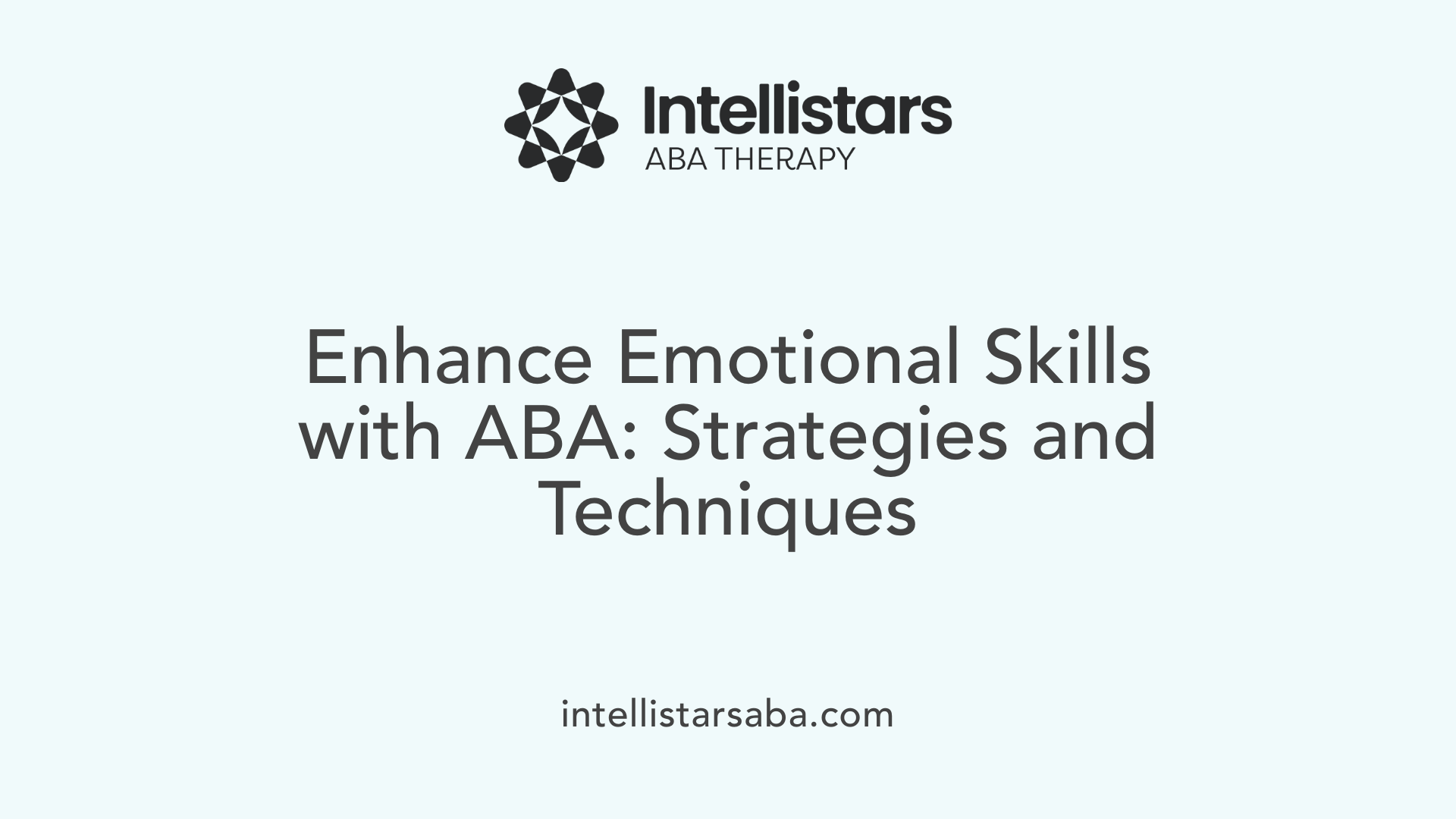
How Are Emotional Recognition and Regulation Connected?
Understanding and recognizing emotions are crucial steps toward developing emotional regulation. For children with autism spectrum disorder (ASD), difficulties in identifying emotions can hinder social development and self-control. ABA-based strategies address this gap by explicitly teaching children to recognize facial expressions, vocal tones, and body language cues through visual tools such as emotion flashcards. This foundational skill helps children become aware of their feelings and those of others.
What Techniques Help Manage Emotional Outbursts?
Mindfulness is a proven technique within ABA frameworks that helps children regulate emotional outbursts. Mindfulness practices guide children to be aware of their emotional state in the moment, promoting calmness and preventing escalation. Additionally, teaching children to identify and label their emotions through repeated activities and interactive games enables them to anticipate and control their reactions more effectively.
How Does Recognizing Personal Emotions Improve Self-Control?
By learning to recognize their own emotions, children gain insight into triggers that lead to challenging behaviors. ABA techniques emphasize the connection between emotions and behavior, empowering children to develop self-regulation strategies. For example, social stories can outline relatable situations and the resulting emotions, illustrating appropriate responses and the benefits of staying calm.
Why Is Emotional Regulation Vital for Social Development?
Emotional regulation supports smoother social interactions by enabling children to respond appropriately in various social contexts. ABA-based instruction in emotional recognition and regulation opens pathways to improve communication, reduce disruptive behaviors, and foster positive relationships. Mastery of these skills helps children generalize their understanding across settings, facilitating greater independence and social success.
Evidence Supporting ABA Therapy for Emotional Skill Development in Autism
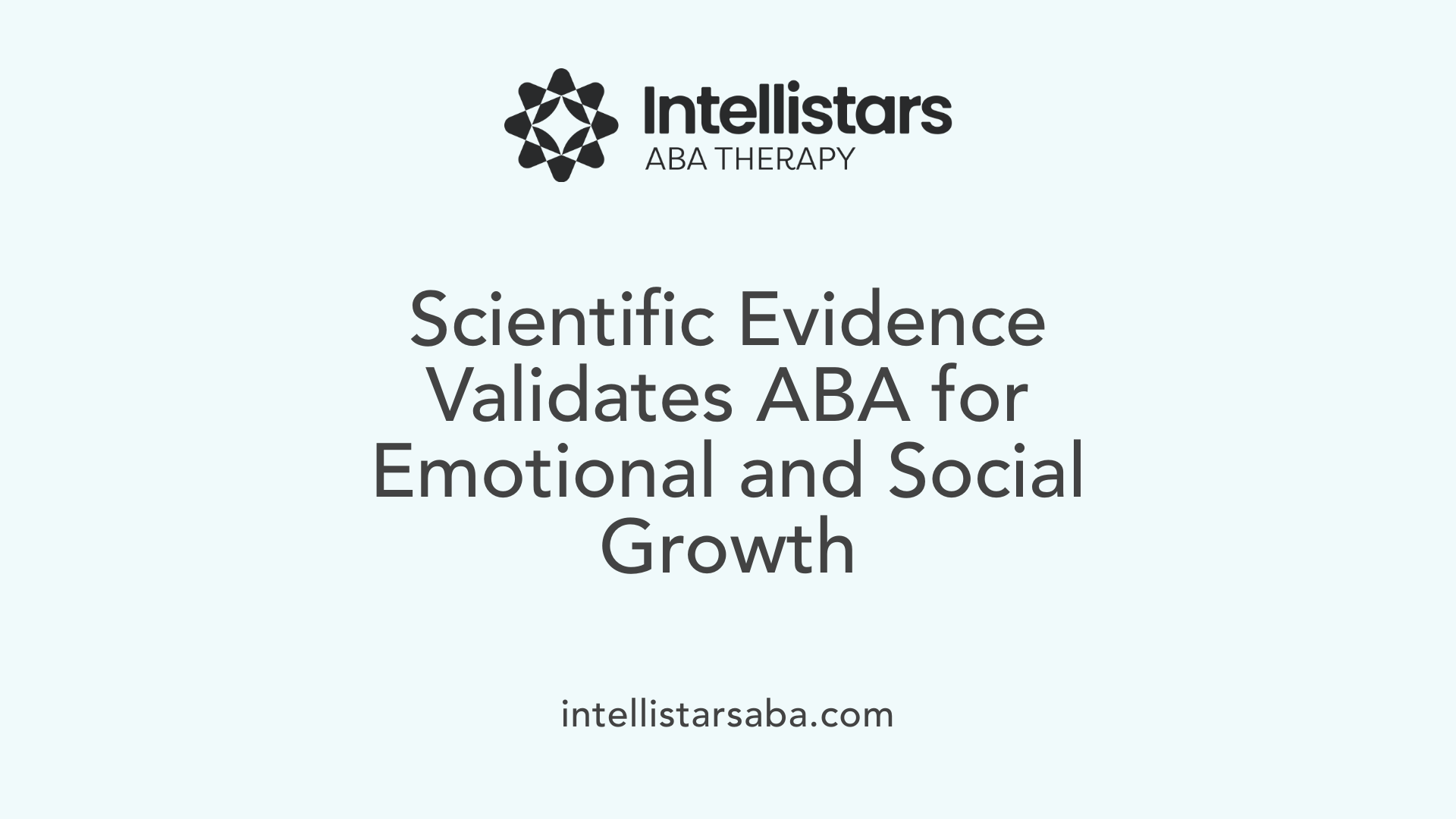
What evidence supports the effectiveness of ABA therapy for individuals with autism?
Numerous scientific studies and clinical reports have confirmed that Applied Behavior Analysis (ABA) therapy significantly benefits individuals with autism spectrum disorder (ASD). These studies reveal marked improvements in communication, social interaction, and adaptive behavior skills.
Professional organizations, including the American Psychological Association and the U.S. Surgeon General, recognize ABA as an evidence-based best practice. This endorsement reflects the therapy’s demonstrated reliability and positive outcomes.
Research highlights the impact of early and intensive ABA interventions. Children receiving these therapies often show notable advancements in language acquisition and reductions in challenging behaviors. ABA’s structured yet flexible methods help foster lasting skill development.
Importantly, ABA techniques promote the generalization of emotional recognition and related skills to real-life contexts. Strategies such as naturalistic teaching and pivotal response treatment encourage children to apply learned social cues and emotional understanding beyond therapy sessions.
By combining individualized plans with positive reinforcement and interactive learning, ABA therapy supports children in better recognizing emotions, communicating effectively, and navigating social environments with increased confidence and independence.
Criticisms and Ethical Considerations in ABA Therapy
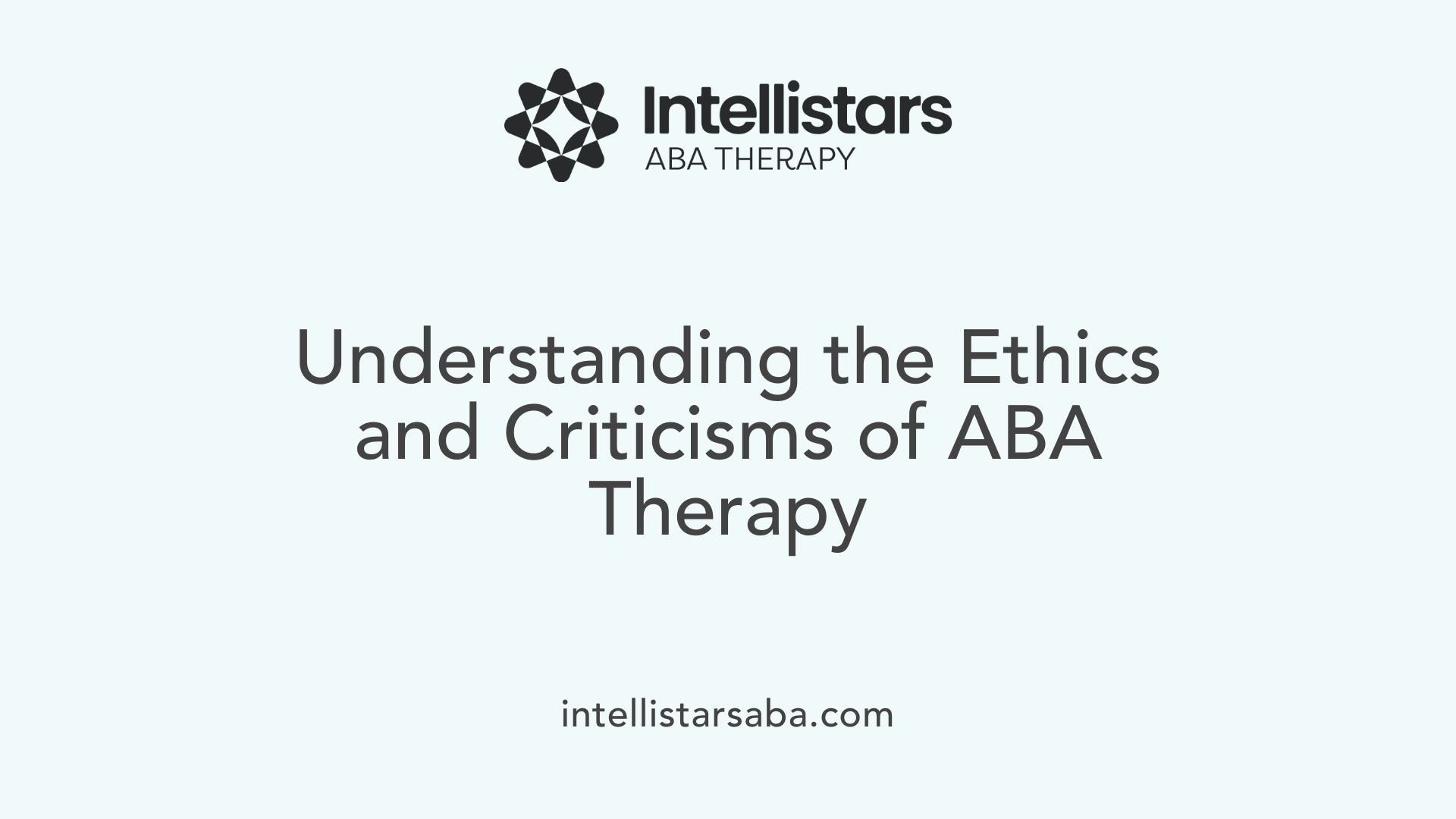
Are there any criticisms or limitations associated with ABA therapy?
Applied Behavior Analysis (ABA) therapy, while effective in many ways, has faced various criticisms concerning its practices and ethical implications. One major concern is that ABA can sometimes be overly intensive, focusing heavily on compliance and behavior modification, which may affect the individual's emotional well-being. This intense focus might lead to emotional distress or cause individuals to lose aspects of their self-identity.
Historically, ABA included aversive methods, such as the use of electric shocks, to reduce unwanted behaviors. Though these practices are no longer accepted or used in modern therapy, their legacy raises ethical debates regarding the use of punishment and the goal of making autistic individuals conform to typical behaviors.
Critics from the neurodiversity movement argue that ABA's efforts to normalize behaviors risk suppressing natural autistic traits. They highlight potential mental health consequences, including anxiety, burnout, and even post-traumatic stress disorder (PTSD), emphasizing that ABA may prioritize reducing behaviors rather than addressing emotional and communicative needs.
Such critiques also point out that focusing solely on behavior management might neglect the importance of emotional support, sometimes resulting in low self-esteem or trauma for children and adults undergoing ABA.
In response to these concerns, modern ABA practices are evolving to emphasize positive reinforcement approaches and individualized care. Greater involvement of stakeholders, including the individuals receiving therapy and their families, promotes ethical treatment that respects dignity and reduces past harms. These efforts strive to balance effective behavioral support while honoring the diverse emotional and identity needs of those with autism.
Maximizing the Impact of ABA Therapy on Emotional Skills
ABA therapy offers a powerful, evidence-based framework for teaching emotional recognition and expression to children with autism. Through individualized, data-driven approaches incorporating strategies like discrete trial teaching, naturalistic instruction, and the use of emotion flashcards, ABA can enhance the foundational skills necessary for understanding and communicating emotions. While the therapy’s effectiveness is well-supported, it is essential to implement ABA with sensitivity to ethical concerns, prioritizing the emotional well-being and individuality of each child. By integrating positive reinforcement with creative teaching tools and emotional regulation techniques, practitioners and families can empower children to navigate their social worlds with greater awareness and confidence.
References
- How to Use ABA in the Classroom
- Emotion Flashcards Autism
- Helping Children with Autism to Communicate & Recognize ...
- How Do You Teach Emotion Concept to Children with ...
- The effectiveness of applied behavior analysis program ...
- The Controversy Around ABA
- Applied Behavior Analysis (ABA)
- 6 Benefits of ABA Therapy for Children with Autism
- The Controversy Around ABA






